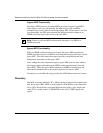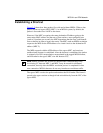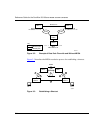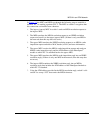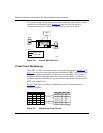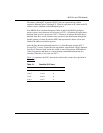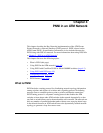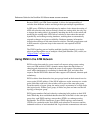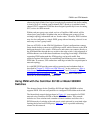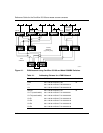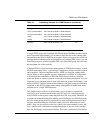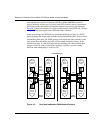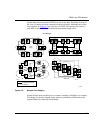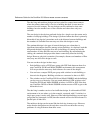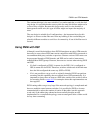
Reference Guide for the Centillion 50/100 and Model 5000BH Switches
4-2
893-01006-C
Because PNNI is an ATM Forum standard, it allows for interoperability of
switches from different vendors and designs that span multiple organizations.
In IISP, every ATM device that might need to make a choice about the routing of
ATM calls must have the choices statically listed in a routing table; the only way
to change the routing table is by manually attaching the device to the switch and
modifying the routing table. PNNI allows switches to learn about the network
dynamically and exchange routing databases, enabling them to automatically
respond to changes in resource availability. Database summary information
includes the exchange of link states between switches. The link group feature used
in IISP networks to prevent loops in the network is not required in PNNI
networks.
The PNNI signaling protocol enables multiple signaling channels on a single
physical port through the use of multiple virtual path identifier (VPI) values (see
“
Logical Links” on page 4-19).
Using PNNI in the ATM Network
PNNI resolves data paths for source routed call requests using source routing
across an ATM network. PNNI’s dynamic nature means that link failures or
changing path characteristics impact the route of call requests. Rerouting can
occur while simultaneously accounting for bandwidth, QoS, and other route
requests. Parallel PNNI links between nodes support call-balanced, alternate-path
redundancy.
PNNI switches form themselves into peer groups based on their network service
access point (NSAP) address. If the NSAP addresses are the same up to a certain
point (called the node level), the switches will be part of the same peer group.
From the outside of a peer group, the entire group is represented as a single node
(the logical node). Within a peer group, all nodes are peers and must see the full
topology of that peer group.
PNNI group members find each other by exchanging hello packets on their NNI
links. When they have established that the other end of the link is in the same peer
group, they send PNNI topology state packets (PTSPs) to exchange routing
information. The PTSPs contain one or more PNNI topology state elements
(PTSEs) for a particular node. Each PNNI node advertises its resources and the
outbound resources of each attached link. Logical nodes communicate with each



